 As Lao-tzu once said, a journey of a thousand miles begins with a single step. The importance of beginnings resonates with astrologers who also reserve a special place for the moment of birth and the planetary imprint of inception. Like the first breath, the first step in a journey occurs in a unique moment in time and is inscribed with an unrepeatable karmic signature.
As Lao-tzu once said, a journey of a thousand miles begins with a single step. The importance of beginnings resonates with astrologers who also reserve a special place for the moment of birth and the planetary imprint of inception. Like the first breath, the first step in a journey occurs in a unique moment in time and is inscribed with an unrepeatable karmic signature.
The moment of inception offers us a map of the stars that can be used to grasp the nature and ultimate trajectory of an action. Unlike birth, the starting point for various human endeavors like travel can be freely chosen. This opens the door to the possibility of choosing or ‘electing’ an auspicious time for initiating an action based on alignments in the sky. The resulting electional charts or muhurthas should therefore be seen as practical tools through which astrology can further the understanding of our destiny and thereby enhance the quality of our lives.
But is it really possible to choose a fortuitous moment to embark on a trip and thereby manipulate the fates in our favour? Jyotish has long asserted that this is indeed the case. Many books have been written on the subject of elections, each detailing any number of rules for undertaking a particular action under the most auspicious star alignments. In his book Muhurta (Electional Astrology), the esteemed astrologer B.V. Raman outlines dozens of rules for successful journeys including auspicious nakshatras, lunar days, rising signs, planetary house placements, days of the week, and house rulers along with specific rules for types of journeys (e.g. sea, business, etc). It is both an impressive and daunting list of potentially important factors to consider when planning a trip.
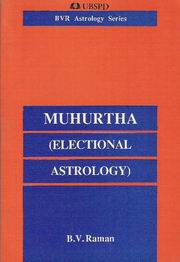 The problem, however, is how one is to put this knowledge into practice. With so many factors to consider, how can we weigh the relative importance of each of them? What if there is a situation where the 1st house/Lagna is strong and occupied by Jupiter as Raman recommends but the Moon is in a bad house with malefics or worse, placed in Krittika, one of his ‘no-go’ nakshatras? Will the trip be a failure or only middling in its outcome? Unfortunately, Raman does not provide any examples to show how some of these sometimes contradictory factors may operate in a real chart. The relative importance of the various rules is therefore left largely unexplored, much less proved, and the reader is left to fend for himself in the vast sea of Jyotish without a compass.
The problem, however, is how one is to put this knowledge into practice. With so many factors to consider, how can we weigh the relative importance of each of them? What if there is a situation where the 1st house/Lagna is strong and occupied by Jupiter as Raman recommends but the Moon is in a bad house with malefics or worse, placed in Krittika, one of his ‘no-go’ nakshatras? Will the trip be a failure or only middling in its outcome? Unfortunately, Raman does not provide any examples to show how some of these sometimes contradictory factors may operate in a real chart. The relative importance of the various rules is therefore left largely unexplored, much less proved, and the reader is left to fend for himself in the vast sea of Jyotish without a compass.
In his defense, it should be noted that Raman probably never intended his books to be comprehensive. For most Indian astrologers, books are often seen as summaries of accumulated knowledge rather than detailed expositions that are intended to persuade the skeptical reader. The concepts laid out there were designed be the basis for further discussion and elaboration between teacher and student.
In this brief article, I would like to remedy this empirical deficit by examining three journeys and discuss the significance of the planetary positions at the time of departure. In examining the logic of electional charts, there are pros and cons with using such famous charts. On the plus side, the departure times are fairly accurate and the outcomes are well-known. One can still debate the nature of the charts of course, but such is the nature of astrology. One possible drawback, however, is that none of these three charts under consideration are genuine muhurta charts. We do not know if any of the times of departure were consciously chosen by an astrologer. They may therefore have been only accidental in the sense that they ‘lucked out’ by leaving under auspicious planets. If we are trying to better understand the rules of freely chosen muhurta charts, these journeys may offer only an indirect window.
For reasons of brevity, I have limited my analysis to the consideration of a very small number of common muhurta rules. By keeping things as simple as possible, I hope that it will become clearer to see how the rules may be working. In a very real sense, the basics of electional astrology are simply the basics of natal astrology. Perhaps the most important factor is the condition of the Moon. The Moon rules emotions and our reactive self and if one is under stress, then it is more likely that one will suffer through negative circumstances. Therefore, a journey that begins when the Moon is well-placed is more likely to yield positive results (however defined) and create the conditions for a sense of fulfillment and happiness along the way. The second key factor is the Lagna or 1st house, also known as the Ascendant. If the Lagna is strong by virtue of aspect, occupation or dispositor, then experiences and outcomes are more likely to be favourable. This would include the placement or aspect from benefics Venus and Jupiter, and to a lesser extent the Moon and Mercury. The lagnesh or ruler of the 1st house also should be included as it is also helpful if it similarly unafflicted by malefics.
The travel charts I have chosen are those of the explorer Christopher Columbus, the scientist Charles Darwin and the writer Jack Kerouac. This disparate collection of charts was chosen largely at random although the final selection depended on the availability and reliability of the departure charts data. For example, I omitted consideration of Ferdinand Magellan’s chart because the time of departure was not clearly indicated in historical sources. That said, I would not deny the possibility of confirmation bias intruding in selection of these examples. This is often unavoidable when dealing with a small number of cases.
In addition to the modest empirical contribution to travel muhurtas, I also wanted to suggest another way we could go about choosing electional charts for travel. Specifically, I want to suggest that not only should we consider the standard rules of when choosing a muhurta, but it may be worthwhile to consider the impact of transits to the muhurta chart at later stages of the journey. The impact of these subsequent transits in longer journeys is a phenomenon that has not been explored in most writing on the subject and may be unknown to many astrologers.
Christopher Columbus – The Expedition to the New World
Christopher Columbus discovered the New World in October 1492 on what would be the first of his three voyages. While the Norse may have actually preceded Columbus by landing in Northeastern Canada in the 11th century, it was the Columbus expedition that marked the beginning of continuous exploration, conquest and colonization of the Americas by Europeans.
According to his journal entry, he departed from the Spanish coastal town of Huelva half an hour before sunrise (at 4.47 a.m.) on August 3, 1492. While the journey was not without moments of difficulty (e.g. one ship had to be abandoned when it ran aground), the expedition was for the most part quite successful. To be sure, Columbus did not ultimately discover a short cut to Asia and returned with an empty hull instead of the hoped for bounty of gold and spices. So while some objectives of the trip were not fulfilled, his efforts revealed the enormous potential of the Americas and Columbus was subsequently financed for future journeys by the Spanish crown.
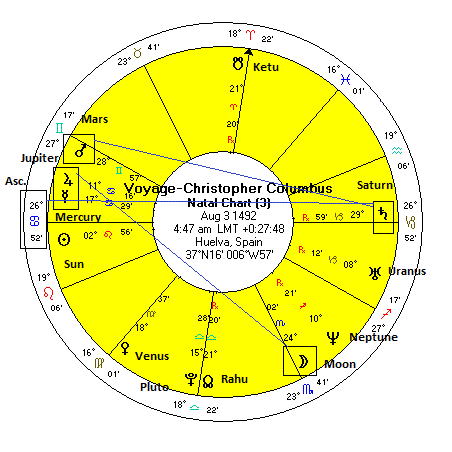
A quick glance at the chart and we can see how some of these characteristics may have manifested. On the plus side, Mercury is conjunct exalted Jupiter in the watery sign of Cancer (sea voyage!) in the Lagna. This is a really positive placement since Mercury is a planet that is closely associated with travel. It also rules the 12th house (Gemini) for long distance travel and remote places. Jupiter is a benefic planet of expansion and fortuitous situations which usually offers a measure of protection for endeavours undertaken when it is prominent in the horoscope.
However, Saturn aspects this pair from the 7th house, albeit in the sign of Capricorn which it rules. Saturn’s aspect to the 1st house is probably unhelpful and may be one reason why the route to Asia was never found and Columbus did not bring back anything of value to Spain. We may also speculate that Saturn in the 7th house denotes the situation of the indigenous people of the Americas. The 7th house often symbolizes “the Other” and hence Saturn may describe their precarious circumstances. Columbus was intent on Christianizing these people who he regarded as uncivilized and primitive. Saturn’s symbolic association with marginalized, poor outsiders and foreigners is perhaps reflected in this very prominent Saturn in the horoscope for Columbus’ journey. We may also wonder if this Saturn also hints at what would become of these indigenous people under the rule of Columbus. Under his subsequent governorship of the island of Hispaniola in the Caribbean, a significant proportion of these native people would suffer under the brutal enslavement and economic exploitation by their European masters. Saturn (indigenous people) comes under the close 8th house aspect from Mars (violence).
The all-important Moon is lagnesh (1st house lord) and it is quite strong in Scorpio in the 5th house. Certainly, its debilitation in Scorpio is not very favourable but in my experience, debilitation can be offset if other chart factors are positive. This is plausible enough here as the Moon receives the aspect of an exalted Jupiter (albeit widely) and it is well-placed in the trikona 5th house. Also, the placement of two benefics, Mercury and Jupiter, in the sign that the Moon rules (Cancer) is very helpful for the Moon. The Moon’s dispositor Mars is poorly placed in the 12th house, but in qualitative terms it is a very apt placement given the expedition’s journey to unknown and distant lands. In this sense, it reminds us that the departure horoscope does not just have to be auspicious and positive but it also should reflect the nature of the journey that is being undertaken. A prominent 12th house is probably going to indicate disappointment and loneliness if one is on a pleasure cruise, but it may not be negative at all if one is seeking to discover new continents beyond the boundaries of the known world. Indeed, given the danger that Columbus faced on the expedition, a Scorpio Moon would likely come in handy. Scorpio Moons tend to be strong-willed and very focused in their tasks and are able to act quickly to combat whatever challenges that may arise.
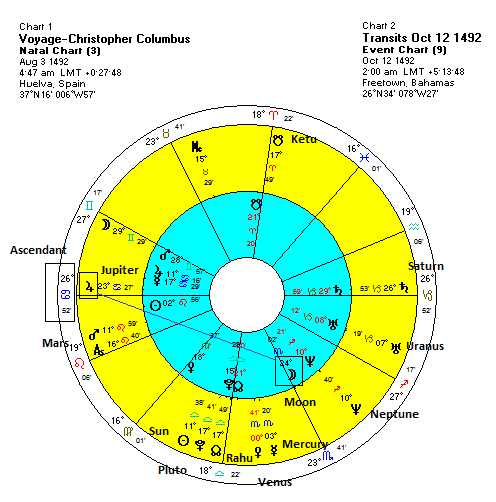
If the chart of the journey offers some clues about the nature of the trip, even more intriguing is how the transits to the departure chart also appear to reflect events that occurred along the way. For example, Columbus first spotted land in the early morning hours of October 12, 1492. At that time, transiting Jupiter (23 Cancer) had moved into a conjunction with the Lagna and a close 5th house aspect with the Moon (23 Scorpio). All of a sudden, that debilitated Moon doesn’t look so bad! The aspect from Jupiter was actually stronger than usual since it was approaching its retrograde station at 25 Cancer in November. This meant it was moving quite slowly at the time of the sighting of the New World and created extended contacts with both the Lagna/Ascendant and the Moon.
Once Jupiter began to move backwards, it would again hit the Moon and then back into a conjunction with the natal Mercury (17 Cancer). I believe that this extended Jupiter influence was one of the astrological keys to understand the success of the first voyage of Columbus. In this sense, the natal chart only tells part of the story of what the expedition would promise. It also mattered what the transits would be for the rest of the trip. If transiting Saturn had closely aspected the Moon instead of Jupiter in the fall of 1492, the results of Columbus’ voyage may have been very different.
Columbus successfully returned to Spain on 15 March 1493 and gained significant fame from his travels. Jupiter (15 Cancer) was just two degrees past its conjunction with Mercury in the 1st house. Moreover, Jupiter would station and complete its retrograde cycle just four days later on March 19. Such slow moving planets are especially powerful and thus the extended Jupiter-Mercury conjunction is a very apt planetary signature for a safe and successful completion to the expedition. Again, the take-away here is the success promised by the muhurta chart is more clearly demonstrated by the subsequent movements of Jupiter in the departure chart. Where the electional chart may be equivocal or difficult to interpret, a quick glance at the key transits provides additional information on the nature of the journey.
We may also take note of the Vimshottari dashas here. Columbus left Spain under the Mercury-Mars dasha. Along with the Moon, Mercury is a planet with the closest associations with travel and movement and its placement in the 1st house should be seen as both appropriate and auspicious. Minor dasha lord Mars is in the 12th house of distant lands so that also should not be surprising given that Columbus was seeking a hitherto uncharted route to Asia. Columbus returned under the Mercury-Rahu dasha. Rahu is placed in the 4th house (land, earth) in conjunction with Pluto (power). Rahu (i.e. North Lunar Node) usually symbolizes situations where boundaries are broken and the status quo is disrupted. It is frequently prominent in efforts to discover new knowledge and new cultural practices. In keyword terms, we can see the Mercury-Rahu dasha at the time of the discovery of America as intentional (1st house) travel (Mercury) to discover (Rahu) new lands (4th house) which completely reshaped and revolutionized (Rahu) the European view of the world.
Charles Darwin – The Voyage of the Beagle
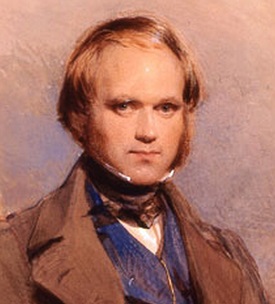 The British naturalist Charles Darwin also embarked on an historic journey that was made under very auspicious stars. Before achieving fame for espousing the theory of evolution in The Origin of Species, the young Darwin journeyed around the world. In 1831, the HMS Beagle undertook a scientific expedition aimed at nautical and geological mapping. As a young naturalist, Darwin was asked to join the expedition for his geological expertise as well as to conduct zoological and anthropological observations. It was this journey that provided the unique insights that guided him towards the conclusion that species were not fixed but rather adaptively evolved according to the circumstances of their environment. His observations of tortoises, mockingbirds and finches on the Galapagos Islands in 1835 were particularly instrumental in this regard. Arguably, this expedition formed the basis of a scientific revolution and helped to usher in the modern secular world-view.
The British naturalist Charles Darwin also embarked on an historic journey that was made under very auspicious stars. Before achieving fame for espousing the theory of evolution in The Origin of Species, the young Darwin journeyed around the world. In 1831, the HMS Beagle undertook a scientific expedition aimed at nautical and geological mapping. As a young naturalist, Darwin was asked to join the expedition for his geological expertise as well as to conduct zoological and anthropological observations. It was this journey that provided the unique insights that guided him towards the conclusion that species were not fixed but rather adaptively evolved according to the circumstances of their environment. His observations of tortoises, mockingbirds and finches on the Galapagos Islands in 1835 were particularly instrumental in this regard. Arguably, this expedition formed the basis of a scientific revolution and helped to usher in the modern secular world-view.
According to the journal of the ship’s captain Robert Fitzroy, the Beagle set sail from Plymouth, England on December 27, 1831 at “daybreak”. We do not have an exact time of departure, so we can cast a sunrise chart and remain flexible about possible interpretive grey areas as they pertain to house placement. Daybreak tends to be a little before the actual sunrise so perhaps the Sun would be a few degrees below the Ascendant.
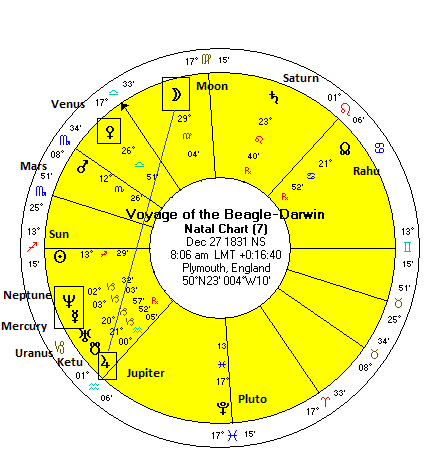
Given the sunrise chart with has Sagittarius rising, the ruler of the 1st house is likely Jupiter. Jupiter is very nicely placed in the 3rd house of efforts and determination and confers a positive energy towards the fulfillment of goals. Perhaps even more noteworthy is that Jupiter had just entered the sign of Aquarius the very day the Beagle set sail (this is true for both Krishnamurti and Lahiri ayanamsha). Such planetary ingresses often coincide and powerful instances where the planetary energy is manifest in its areas of rulership. It seems incredible that the journey that led to the development of the theory of evolution should begin when Jupiter (knowledge, expansion) should have entered the sign of Aquarius (innovation, science). It also noteworthy that the detached Aquarius influence complemented the more ethical side of the Sagittarius Ascendant as the journey would have both profound scientific and philosophical implications.
The other telling placement in this chart is the Moon. The Moon is extremely strong here by virtue of its placement in Virgo (analytical thought), in the 10th house (status, fame) and most of all by the almost exact 9th house, 120 degree aspect from Jupiter. (Yes, Virgo is actually eight houses away from Aquarius, but the degree aspect is so close that this 120 degree aspect should be considered) Generally speaking, the closer the aspect to exact, the more powerful the influence from the aspecting planet. Since Jupiter is just one degree from forming an exact aspect, this Moon was very strong and well-endowed and was that much more able to deliver favourable results for this endeavour. Also telling is the fact that the Moon is the ruler of the 8th house (Cancer) in this natal chart thus represents research into the unknown.
The other alignment of note is that Mercury (3 Capricorn) is closely conjunct Neptune (2 Capricorn) in the second house. Mercury is a planet of travel so it not at all strange that it should be connected with watery Neptune, the god of the sea for a voyage around the world. We may also speculate whether some of the communication and writing (Mercury) as a result of this voyage may have had a Neptunian character. Neptune is a planet of idealistic vision and transcendence and its influence on Mercury may reflect how Darwin’s subsequent writings on evolution might have reflected this ability to address some perennial questions on the origins of human existence. In this sense, the Mercury-Neptune conjunction can be seen as part of the deeper ethical and spiritual implications of Darwin’s work. (Parenthetically, The Origin of Species was published in November 1859 when this Mercury-Neptune conjunction came under the exact stationary aspect from Jupiter (3 Cancer). Jupiter was in its highest degree of exaltation at the time and just two weeks from its retrograde station.
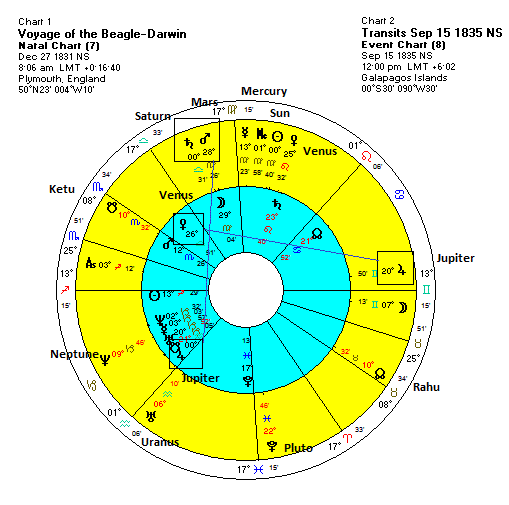
Darwin’s most pivotal experience on the trip was his zoological survey of the Galapagos Islands. This is where he encountered finches, mockingbirds and tortoises, each differing slightly in their appearance depending on which island in the archipelago they inhabited. It was this work of collection, classification and research that would plant the seed for his idea of evolution based on natural selection. The Beagle reached the Galapagos on 15 September 1835 and stayed for a little over a month.
As the transit chart shows, Saturn had just entered Libra a few days prior to Darwin’s arrival and was closely conjunct the Moon. Transiting Mars was also there just a couple of degrees away, perhaps acting as a faster-moving triggering planet. Of course, one may wonder how these two natural malefics could possibly be associated with circumstances that led to one of the most important scientific insights in human history. To be sure, Saturn has a well-deserved reputation for creating problems and obstacles. However, it also has a good side. It symbolizes industriousness, balance, focus, order and structure. All of these qualities are both necessary and helpful for life and prosperity. However, they only arise when Saturn is well-placed. I would argue that is most definitely the case here since Saturn had just entered Libra, the sign of its exaltation, a few days before. Saturn is much more likely to exhibit its highest qualities in Libra than any other sign.
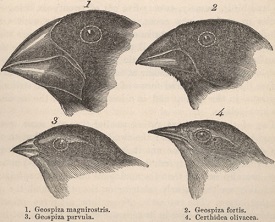 Also, it is important to remember that it was exactly aspected by the natal Jupiter. That powerful Moon-Jupiter alignment was being activated by the arrival of Saturn. Such well-placed Jupiter-Saturn aspects are usually quite positive and reflect stable and balanced situations that are characterized by good organization. Darwin’s zoological research was very much focused on classifying the various species he found on the islands. Higher knowledge (Jupiter) was gained through the methodical (Saturn) process of classifying and ordering (Saturn) the slight differences he encountered there. The meticulous nature of his work on the tortoises and finches offers a plausible manifestation of this newly ingressed Jupiter (into Aquarius, no less!) and similarly newly exalted Saturn in Libra. I would also suggest that Saturn was perhaps more likely to be involved in the acquisition of knowledge because it was occupying the 9th house (Leo) of higher knowledge in the departure chart. Finally, given the generally favourable planetary positioning of these planets, we can perhaps better understand the Mars transit influence as the energy and enthusiasm with which Darwin and his colleagues on the Beagle undertook to immerse themselves in these strange and exotic surroundings.
Also, it is important to remember that it was exactly aspected by the natal Jupiter. That powerful Moon-Jupiter alignment was being activated by the arrival of Saturn. Such well-placed Jupiter-Saturn aspects are usually quite positive and reflect stable and balanced situations that are characterized by good organization. Darwin’s zoological research was very much focused on classifying the various species he found on the islands. Higher knowledge (Jupiter) was gained through the methodical (Saturn) process of classifying and ordering (Saturn) the slight differences he encountered there. The meticulous nature of his work on the tortoises and finches offers a plausible manifestation of this newly ingressed Jupiter (into Aquarius, no less!) and similarly newly exalted Saturn in Libra. I would also suggest that Saturn was perhaps more likely to be involved in the acquisition of knowledge because it was occupying the 9th house (Leo) of higher knowledge in the departure chart. Finally, given the generally favourable planetary positioning of these planets, we can perhaps better understand the Mars transit influence as the energy and enthusiasm with which Darwin and his colleagues on the Beagle undertook to immerse themselves in these strange and exotic surroundings.
For the subsequent five weeks Darwin was in the Galapagos, Saturn and Mars in Libra were joined by Mercury, Sun and Venus. The success of their research efforts was remarked upon at the time and probably was the high water mark of the entire voyage. This is perhaps not surprising given that all those planets in Libra were also in the natal 11th house which represents gains and wishes fulfilled. I would also note that by the time the Beagle left on 20 October, transiting Jupiter (24 Gemini) was very close to its exact aspect upon the 11th lord Venus (26 Libra). Again, this would be a very auspicious indication of ‘goals achieved’.
The dashas in the departure chart were also broadly reflective of the nature of the journey. The departure chart occurred under Mars-Saturn dasha. Mars is well-placed as 12th lord of the 12th house (journeys to remote places) while Saturn is the 2nd and 3rd lord (communications, efforts) in the 9th house of higher knowledge and long distance travel. Saturn is disposited by the Sun which is rising in the 1st house.
By the time the Darwin and the Beagle arrived in the Galapagos, the Mars-Moon dasha was underway. The super-strong Moon is the 8th lord (unknown or hidden things) placed in the 10th house of status and career in Virgo (logic, analysis) aspected by Jupiter (expansion, wisdom).
As in the case of Columbus, we can see that positive developments during the course of a particular journey may be more likely to occur when there are favourable transit hits to the departure chart. As elections, departure charts therefore may be chosen not only with a good natal chart in mind, but also with an eye for finding subsequent good transits.
Jack Kerouac – First journey across the USA
 Our last example is the travels of the American writer Jack Kerouac. Kerouac’s most famous book, On the Road, was published in 1957 and is credited with starting the beatnik movement and later, the hippie movement of the 1960s. The book depicts the adventures of a group of carefree and exuberant young people in search of identity and meaning in post-war America. On the Road was closely based on Kerouac’s own travel experiences and can for all intents and purposes be read as an autobiography.
Our last example is the travels of the American writer Jack Kerouac. Kerouac’s most famous book, On the Road, was published in 1957 and is credited with starting the beatnik movement and later, the hippie movement of the 1960s. The book depicts the adventures of a group of carefree and exuberant young people in search of identity and meaning in post-war America. On the Road was closely based on Kerouac’s own travel experiences and can for all intents and purposes be read as an autobiography.
For readers who may be unfamiliar with Jack Kerouac, On the Road was a hugely influential book in the late 1950s and 1960s. It documented important cultural changes that were bubbling up under the surface in the United States that would eventually find full voice in the tumultuous 1960s. Kerouac’s characters rejected the tradition and conformity of 1950s America in favour of a more authentic and self-directed experience of life. On the Road has been widely cited as a major cultural influence and acted as a guide to a new way of thinking and living. Bob Dylan said, “It changed my life like it changed everyone else’s.” It is possible to draw a straight line from Kerouac to the hippies, through to the liberalizing tendencies of the 1970s, and indeed down to our own more self-focused society of today.
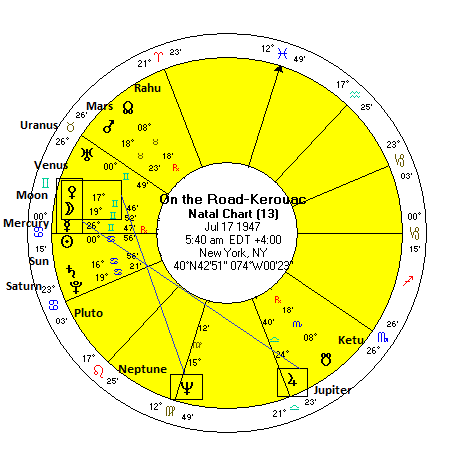
As a 25 year-old aspiring writer, Jack Kerouac embarked on his first cross country trip on July 17, 1947 near sunrise. His aim was to hitchhike from his home in New York to San Francisco while meeting up with friends along the way. This was the first of three such trips he made in the late 1940s that formed the basis of the narrative in On the Road. While we don’t know exactly what time he left his home, we do know it was around daybreak (“au petit matin” in French) and therefore we can tentatively use the sunrise chart. The Ascendant in the departure chart is therefore either Gemini or Cancer. By any measure, this is a remarkable chart. The Moon, Mercury and Venus are all tightly conjoined in Gemini and all three are also very closely aspected by benefic Jupiter (24 Libra). Clearly, all of those planets are going to be strengthened by Jupiter’s aspect, especially Mercury (writing, travel, communication) which is retrograde and well-placed in its own sign and is closest to the exact aspect with Jupiter. Jupiter is made even more powerful because it had just turned direct one day before. As we have noted, planets near their stations take on a special strength due to their unusually low velocity.
 It is hard to imagine and more auspicious departure chart for a person who would end up writing about his travel experiences. Mercury is the planet most associated with writing and it is placed in its own sign (Gemini) and is also associated with writing. Further, it is aspected by Jupiter (expansion, fortune) and conjunct benefics Moon (emotion, imagination) and Venus (art, beauty). And if Kerouac had departed at first light just before dawn, then all those planets in Gemini move to the 1st house. This would also be quite telling for a trip that was so focused on the search for the authentic self and personal development. When the ruler of the 1st house is placed in the 1st house (Mercury) and is boosted by benefics as is the case here, it should reflect high levels of independence, life purpose, and vitality. Kerouac’s ebullient, self-directed search for authenticity that ultimately found its way onto the pages of On the Road is captured nicely by this very prominent and auspicious 1st house.
It is hard to imagine and more auspicious departure chart for a person who would end up writing about his travel experiences. Mercury is the planet most associated with writing and it is placed in its own sign (Gemini) and is also associated with writing. Further, it is aspected by Jupiter (expansion, fortune) and conjunct benefics Moon (emotion, imagination) and Venus (art, beauty). And if Kerouac had departed at first light just before dawn, then all those planets in Gemini move to the 1st house. This would also be quite telling for a trip that was so focused on the search for the authentic self and personal development. When the ruler of the 1st house is placed in the 1st house (Mercury) and is boosted by benefics as is the case here, it should reflect high levels of independence, life purpose, and vitality. Kerouac’s ebullient, self-directed search for authenticity that ultimately found its way onto the pages of On the Road is captured nicely by this very prominent and auspicious 1st house.
The other noteworthy pattern in this chart is the square aspect between Neptune (15 Virgo) and the Moon-Venus conjunction in Gemini. Since this was a work from the realm of imagination, it is perhaps fitting that Neptune should be so prominent. Neptune is a more ethereal and visionary planet and therefore its influence is less likely to be rational or factual, particularly when forming a tense square aspect. The other way of looking at this Neptune influence, however, is to acknowledge some of the dissolute nature of Kerouac’s adventures. When it is involved in a hard aspect as it is here, Neptune is prone to self-delusion and self-abuse. The book includes accounts of alcohol and drug-fueled parties (Moon-Neptune) while romantic attachments (Venus-Neptune) were usually fleeting or ill-conceived. Indeed, the book that emerged from this trip would inspire the beatnik and hippie movements which were characterized by extensive recreational drug use and sexual experimentation.
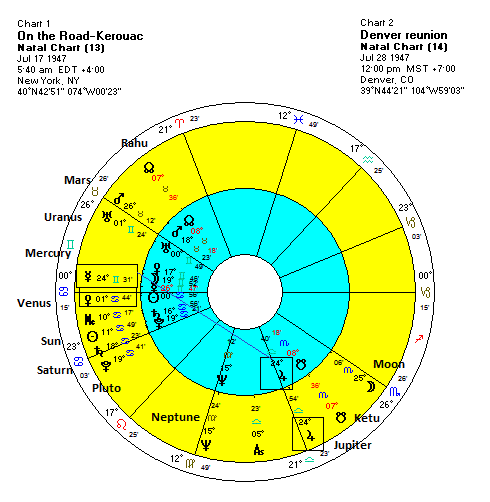
Kerouac enjoyed a particularly happy reunion with his friends in Denver on 28 July, among them the poet Allen Ginsberg and his literary muse Neal Cassady. This reunion formed the raw material for some of the more evocative passages in On the Road. The transit hits to the departure chart were clearly positive as we would expect. Transiting Venus (1 Cancer) had conjoined the natal Sun (0 Cancer) while transiting Mercury (24 Gemini) was in an exact 5th house/120 degree aspect with Jupiter. Mercury had ended its retrograde cycle four days earlier at 23 Gemini and thus was in close aspect with Jupiter for several days.
Actually, the Jupiter influence was heightened further by virtue of the fact that they entire three-month trip took place under Jupiter-Jupiter dasha according to Krishnamurti ayanamsha. As the Great Benefic, a Jupiter dasha is probably going to be a helpful influence more times than not. Jupiter in Libra is disposited by Venus and as we have seen, Venus is in good condition in close conjunction with the Moon and Venus, the Neptune aspect notwithstanding.
Kerouac ended his trip in late October and returned to New York as transiting Jupiter (growth) was conjunct the natal Ketu (liberation, enlightenment) while transiting Ketu (1 Scorpio) had moved into an exact 120 degree aspect with the Sun (0 Cancer) (self, vitality). These two Ketu influences at the end of the journey are somewhat appropriate as Ketu is associated with notions of change and undermining the status quo. In terms of travelling, Ketu may therefore be associated with detours, changes in plan, and ultimately, endings. They may also represent the new sense of self-awareness and maturity that Kerouac enjoyed after completing such a formative journey.
Conclusion
 As we have seen from these three journeys, Raman’s essential points regarding the Moon and the 1st house hold up quite well. Successful journeys should typically have well-placed Moons and fortified Lagnas and 1st house lords. This is not to say that the matter is self-evident, since astrologers may differ in their interpretation as to what constitutes a strong Moon. While sign placement, nakshatra placement, and house rulership likely play some role, I would suggest that close association with benefics such as Jupiter and Venus is perhaps the simplest and most reliable way to ensure a good Moon. Further empirical investigations can clarify how we can best choose between these often contradictory factors.
As we have seen from these three journeys, Raman’s essential points regarding the Moon and the 1st house hold up quite well. Successful journeys should typically have well-placed Moons and fortified Lagnas and 1st house lords. This is not to say that the matter is self-evident, since astrologers may differ in their interpretation as to what constitutes a strong Moon. While sign placement, nakshatra placement, and house rulership likely play some role, I would suggest that close association with benefics such as Jupiter and Venus is perhaps the simplest and most reliable way to ensure a good Moon. Further empirical investigations can clarify how we can best choose between these often contradictory factors.
The other observation that emerges from this brief review is that electional charts for travel may not be a case of ‘one size fits all’. People travel for different purposes and this should be reflected in the planetary alignment at the time of departure. Columbus sought to discover new lands and trading routes and hence his prominent 4th and 12th house influences were quite appropriate to these goals. Darwin’s journey on the Beagle was aimed at collecting data in the hopes of increasing knowledge of the natural world. In this way, his strong 8th house Moon (research) and 9th house Saturn (‘ordered knowledge’) could be boosted by the influence of Jupiter in both the natal and transit charts. Kerouac sought out authentic experience and adventure as a means to communicate his vision of the world. Mercury in Gemini was perhaps the best way to facilitate this aim, especially when it was associated with the Moon, Venus and Jupiter.
The implication here is that travel muhurtas are therefore best chosen according to the intended aim of the trip. Vacations with significant social interaction are probably better served by a prominent Venus and Moon. Trips where solitude and quiet are desired may have better results if the 12th house or Ketu is highlighted in some way. Business trips may fare better with a strong Mercury (commerce), and 7th house. However, the common denominator here is that all trips would likely benefit from a good Moon and 1st house irrespective of other factors.
 The other lesson we have learned from these charts is the importance of transits to the departure chart. Whatever the attributes of the electional chart for the journey, it also matters where the planets in that chart are going once the trip has commenced. Columbus first made landfall in America just as transiting Jupiter was conjunct the Ascendant of the departure chart and in a very close aspect with the Moon. This subsequent movement of Jupiter was not reflected in the departure chart alone. Certainly, Jupiter’s natal aspect to the Moon and conjunction with Mercury were likely helpful. But we can well ask: what if Jupiter was retrograde in the departure chart so that it would never make an exact aspect with the Lagna or the Moon during the course of the journey? I would suggest that might have produced different results. Therefore, it makes sense to take into account the future transits of the planets after the trip is underway. For example, if a poorly-placed Saturn is due to form a square aspect to the Moon or Venus sometime after departure, then the prospects for the trip may be significantly diminished during the time that the transit is effective.
The other lesson we have learned from these charts is the importance of transits to the departure chart. Whatever the attributes of the electional chart for the journey, it also matters where the planets in that chart are going once the trip has commenced. Columbus first made landfall in America just as transiting Jupiter was conjunct the Ascendant of the departure chart and in a very close aspect with the Moon. This subsequent movement of Jupiter was not reflected in the departure chart alone. Certainly, Jupiter’s natal aspect to the Moon and conjunction with Mercury were likely helpful. But we can well ask: what if Jupiter was retrograde in the departure chart so that it would never make an exact aspect with the Lagna or the Moon during the course of the journey? I would suggest that might have produced different results. Therefore, it makes sense to take into account the future transits of the planets after the trip is underway. For example, if a poorly-placed Saturn is due to form a square aspect to the Moon or Venus sometime after departure, then the prospects for the trip may be significantly diminished during the time that the transit is effective.
Perhaps the elephant in the room here is the role of the natal chart. Finding an auspicious muhurta chart for travel is all well and good, but if a person’s natal chart is afflicted for the time of the trip then good results may not be forthcoming. In other words, is it possible to somehow override our birth karma by employing astrological knowledge to schedule our willful endeavors? As far as I know, there is no clear answer to this question. I tend to believe that nothing happens in life that isn’t already indicated by the natal chart. But even here we should acknowledge that we don’t fully know how natal charts work and therefore additional muhurta charts can provide complementary information to round out our understanding. Astrology is not a perfect science and predictions do not always come true. That means that there are going to be gaps in our knowledge that could be filled by supplementary charts such as electionals. While it remains to be seen if an auspicious electional chart can override a bad natal transit set-up, it may still make sense to do what one can to minimize any potential damage.
To this end, Raman reminds us of the importance of choosing an electional chart that is “sympathetic” with the person’s natal chart. This may provide an additional connection between the action at hand and the immutable karma of the person who undertakes it. Kerouac’s road adventure was begun when his natal Sun (28 Aquarius) was under the close aspect of transiting Jupiter (24 Libra) and ended when Jupiter (7 Scorpio) had moved into an exact aspect with his Venus (6 Pisces). Darwin’s journey commenced when transiting Jupiter (0 Aquarius) was closely conjunct his Sun (1 Aquarius) and in close aspect with his Lagnesh Mars (4 Libra). Columbus’s date of birth is unknown.
The natal chart therefore becomes another essential factor in choosing a good date for departure. Travels are more likely to go well if the natal chart is well-disposed without any major afflictions involving malefics. In that sense, the story ends where it began – at the moment of birth and the journey of life that begins with the first breath. In that sense, there may be no way to sidestep or transcend one’s natal chart. But as we have seen here, there may still be ways in which the unfolding of our karma can be guided depending on the muhurta of our choosing.


